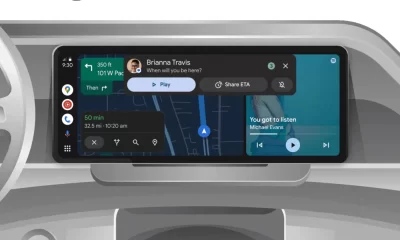Google rollsout Gemini Live to free users, Chrome introduces one-tap unsubscribe, and Google Photos improves clutter management

Top 3 Key Points:
- Gemini Live Available to Free Users: Google extends Gemini Live for free Android users, allowing conversational AI interactions.
- Chrome Enhances Security with One-Tap Unsubscribe: Google Chrome adds a feature to easily unsubscribe from web notifications and revokes permissions from unwanted sites.
- Google Photos Boosts Clutter Management: New options to control backed-up content and third-party app images are coming to Google Photos.
Google is expanding its popular Gemini Live feature, initially available to Advanced subscribers, to all free Android users. Gemini Live enables users to interact in real time with an AI, allowing fluid conversations where users can interrupt and add new information during a session. You can access it via a circular waveform icon at the bottom-right corner of the Gemini interface. Once activated, Gemini Live runs in the background, and users can stop the session by either tapping a button or saying “Stop.”
Although the feature is still missing Gemini Extensions that will let it access apps like Gmail and YouTube Music, these capabilities are expected soon. Gemini Live also introduces 10 new voices, each with different tones and characteristics, allowing users to personalize their experience further.
Currently, Gemini Live is available in English on Android devices, with more languages on the way.
Chrome’s New Notification Controls
Google Chrome is also improving user safety and control with a new one-tap “Unsubscribe” button for web notifications. Initially available on Pixel devices, this feature is rolling out to more Android devices soon. Chrome will automatically run Safety Check in the background, checking for compromised passwords, and outdated versions, and ensuring Safe Browsing is turned on. Chrome will also take steps to revoke permissions from sites no longer in use or flagged as deceptive.
Safety Check’s one-time permissions for camera and microphone access will be revoked after leaving a website, ensuring better privacy. On desktop, the tool will also flag risky Chrome Extensions and offer quick removal options. Chrome’s proactive security approach has already reduced notification volume by 30% on supported devices, and it is expected to have a wider impact as more users adopt the feature.
Google Messages Shrinks Gemini Button
Meanwhile, in Google Messages, the floating action button (FAB) for Gemini has been scaled back to its original size. After being enlarged last month, the button is now smaller, providing a more subtle experience without covering significant screen space. The more compact design makes it less obtrusive, which could encourage more users to keep it enabled.
Google Photos Enhances Clutter Management
Google Photos, a favorite app for managing photos and videos, is working on improved clutter management. Users who back up content from third-party apps will soon have more control over how these images appear in their feeds. An option to show only backed-up images from third-party apps is under development, giving users a cleaner, more organized view of their photos.
Additionally, Google Photos will soon show how many photos in each device folder still need to be backed up, helping users manage their storage more effectively. Although this feature is still in development, it promises to offer more control over cloud backups.
These improvements are expected to make Google Photos even more efficient for managing device folders and third-party app content, though the feature isn’t live just yet.
Google Meet gets a fresh new look with Material 3 design

Google Meet is getting a big update to its look, thanks to the new Material 3 design. This change brings a cleaner and more modern style to the video calling app, making it easier and more enjoyable to use.
With Material 3, Google Meet now has rounder buttons, softer colors, and better spacing between elements. The main controls, like the microphone, camera, and end call buttons, are now larger and easier to tap. The icons and text are also clearer, which helps users find what they need quickly during a call.
Another improvement is the new “expressive” color system. This feature lets the app’s colors match your device’s wallpaper or theme, giving each user a unique and personalized experience. The changes also make Google Meet more accessible, as the new design is easier to read and use for everyone, including people with vision difficulties.
These updates are rolling out to both web and mobile versions of Google Meet. Google says the new look will help people feel more comfortable and focused during their meetings. Overall, the Material 3 update makes Google Meet not only look better but also work better for all its users.
Android
Easy ways to change Android Auto’s look with light and dark themes

Android Auto is a helpful tool that lets you use your phone’s apps safely while driving. It connects your phone to your car’s screen, making it easier to use maps, music, and calls. One of the features many people like is the ability to change how Android Auto looks by switching between light and dark themes.
How to switch between light and dark themes
Android Auto offers two main themes: light and dark. The light theme uses brighter colors, which can make the screen easier to see during the day. The dark theme uses darker colors, which can be more comfortable for your eyes at night or in low light.
To change the theme, follow these steps:
- Open the Android Auto app on your phone.
- Go to the settings menu.
- Find the “Theme” option.
- Choose between “Light,” “Dark,” or “Set by car” (this lets your car decide the theme based on the time of day or your car’s settings).
Why themes matter
Using the right theme can make driving safer and more comfortable. The light theme is good for bright days, while the dark theme helps reduce glare at night. Having these options means you can pick what works best for you, making Android Auto easier to use in any condition.
In short, Android Auto’s theme options are simple to use and help you drive more safely by making the screen easy to see, no matter the time of day.
Google Drive and Files by Google get fresh updates for easier use

Google is rolling out some helpful updates to two of its popular apps: Google Drive and Files by Google. These changes are designed to make managing your files and watching videos much smoother.
First, Google Drive is getting a new video player. Now, when you upload a video to Drive and open it, you’ll notice a fresh look that matches Google’s latest design style. The controls, like play and pause, are easier to use and look cleaner. This update makes it simpler to watch videos directly in Drive without needing to download them first.
Meanwhile, the Files by Google app is also getting a makeover. The app is adopting Google’s Material 3 design, which means it looks brighter and more modern. The buttons and menus are easier to see and use, making it simpler to find, move, and organize your files. There are also new color options and improved icons, so everything feels more user-friendly.
Both updates show Google’s commitment to making its apps more helpful and enjoyable to use. Whether you’re watching videos in Drive or sorting files on your phone, these changes aim to save you time and make things less complicated. If you use these apps, keep an eye out for these new features—they should arrive soon!
-

 Apps1 year ago
Apps1 year agoGboard Proofread feature will support selected text
-

 News1 year ago
News1 year agoSamsung USA crafting One UI 6.1.1
-

 Apps1 year ago
Apps1 year agoGoogle Contacts app testing new Besties Widget
-

 AI12 months ago
AI12 months agoGoogle Pixel 9 Pro may come with a complimentary one-year Gemini Advanced subscription
-

 Apps12 months ago
Apps12 months agoGoogle working on a new video editing feature for its Photo app
-

 Apps12 months ago
Apps12 months agoGoogle Maps lets you report traffic jams and accidents on Apple CarPlay, but not on Android Auto
-

 Apps1 year ago
Apps1 year agoGoogle Messages app will transform MMS chats into RCS
-

 News1 year ago
News1 year agoBreaking: Samsung Galaxy S22 may get Galaxy AI features










